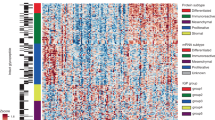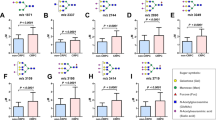Abstract
Background
There is a need for diagnostic tests for screening, triaging and staging of epithelial ovarian cancer (EOC). Glycoproteomics of blood samples has shown promise for biomarker discovery.
Methods
We applied glycoproteomics to serum of people with EOC or benign pelvic masses and healthy controls. A total of 653 analytes were quantified and assessed in multivariable models, which were tested in an independent cohort. Additionally, we analyzed glycosylation patterns in serum markers and in tissues.
Results
We identified a biomarker panel that distinguished benign lesions from EOC with sensitivity and specificity of 83.5% and 90.1% in the training set, and of 86.7 and 86.7% in the test set, respectively. ROC analysis demonstrated strong performance across a range of cutoffs. Fucosylated multi-antennary glycopeptide markers were higher in late-stage than in early-stage EOC. A comparable pattern was found in late-stage EOC tissues.
Conclusions
Blood glycopeptide biomarkers have the potential to distinguish benign from malignant pelvic masses, and early- from late-stage EOC. Glycosylation of circulating and tumor tissue proteins may be related. This study supports the hypothesis that blood glycoproteomic profiling can be used for EOC diagnosis and staging and it warrants further clinical evaluation.
This is a preview of subscription content, access via your institution
Access options
Subscribe to this journal
Receive 24 print issues and online access
$259.00 per year
only $10.79 per issue
Buy this article
- Purchase on Springer Link
- Instant access to full article PDF
Prices may be subject to local taxes which are calculated during checkout




Similar content being viewed by others
Data availability
Glycoproteomic data are available at ftp://massive.ucsd.edu/v07/MSV000094219/
References
Siegel RL, Miller KD, Wagle NS, Jemal A. Cancer statistics, 2023. CA Cancer J Clin. 2023;73:17–48.
Lheureux S, Gourley C, Vergote I, Oza AM. Epithelial ovarian cancer. Lancet. 2019;393:1240–53.
Matulonis UA, Sood AK, Fallowfield L, Howitt BE, Sehouli J, Karlan BY. Ovarian cancer. Nat Rev Dis Prim. 2016;2:1–22.
Lu KH. Screening for ovarian cancer in asymptomatic women. JAMA. 2018;319:557.
Bullock B, Larkin L, Turker L, Stampler K. Management of the adnexal mass: considerations for the family medicine physician. Front Med. 2022;9:913549.
Felder M, Kapur A, Gonzalez-Bosquet J, Horibata S, Heintz J, Albrecht R, et al. MUC16 (CA125): tumor biomarker to cancer therapy, a work in progress. Mol Cancer. 2014;13:129.
Duffy MJ, Bonfrer JM, Kulpa J, Rustin GJS, Soletormos G, Torre GC. CA125 in ovarian cancer: European Group on Tumor Markers guidelines for clinical use. Int J Gynecol Cancer J Int Gynecol Cancer Soc. 2005;15:679–91.
Charkhchi P, Cybulski C, Gronwald J, Wong FO, Narod SA, Akbari MR. CA125 and ovarian cancer: a comprehensive review. Cancers. 2020;12:3730.
Dochez V, Caillon H, Vaucel E, Dimet J, Winer N, Ducarme G. Biomarkers and algorithms for diagnosis of ovarian cancer: CA125, HE4, RMI and ROMA, a review. J Ovarian Res. 2019;12:28.
Skates SJ. Ovarian cancer screening: development of the Risk of Ovarian Cancer Algorithm (ROCA) and ROCA screening trials. Int J Gynecol Cancer. 2012;22:S24–6.
Javdekar R, Maitra N. Risk of Malignancy Index (RMI) in evaluation of adnexal mass. J Obstet Gynecol India. 2015;65:117–21.
Montagnana M, Danese E, Ruzzenente O, Bresciani V, Nuzzo T, Gelati M, et al. The ROMA (Risk of Ovarian Malignancy Algorithm) for estimating the risk of epithelial ovarian cancer in women presenting with pelvic mass: is it really useful? Clin Chem Lab Med. 2011;49:521–5.
Yurkovetsky ZR, Linkov FY, E Malehorn D, Lokshin AE. Multiple biomarker panels for early detection of ovarian cancer. Future Oncol. 2006;2:733–41.
McIntosh M, Anderson G, Drescher C, Hanash S, Urban N, Brown P. Ovarian cancer early detection claims are biased. Clin Cancer Res. 2008;14:7574–7574.
Coates RJ, Kolor K, Stewart SL, Richardson LC. Diagnostic markers for ovarian cancer screening: not ready for routine clinical use. Clin Cancer Res. 2008;14:7575–6.
Check E. Running before we can walk? Nature. 2004;429:496–7.
Bristow RE, Smith A, Zhang Z, Chan DW, Crutcher G, Fung ET. Ovarian malignancy risk stratification of the adnexal mass using a multivariate index assay. Gynecol Oncol. 2013;128:252–9.
Ueland FR, Desimone CP, Seamon LG, Miller RA, Goodrich S, Podzielinski I, et al. Effectiveness of a multivariate index assay in the preoperative assessment of ovarian tumors. Obstet Gynecol. 2011;117:1289.
Lertkhachonsuk AA, Buranawongtrakoon S, Lekskul N, Rermluk N, Wee-Stekly WW, Charakorn C. Serum CA19-9, CA-125 and CEA as tumor markers for mucinous ovarian tumors. J Obstet Gynaecol Res. 2020;46:2287–91.
Hilger WS, Magrina JF, Magtibay PM. Laparoscopic management of the adnexal mass. Clin Obstet Gynecol. 2006;49:535.
Schuueler J, Trimbos J, Hermans J. The yield of surgical staging in presumed early stage ovarian cancer. Int J Gynecol Cancer. 1998;8:95–102.
Young RC, Decker DG, Wharton JT, Piver MS, Sindelar WF, Edwards BK. Staging laparotomy in early ovarian cancer. JAMA. 1983;250:3072–6.
Alley WR, Vasseur JA, Goetz JA, Svoboda M, Mann BF, Matei DE, et al. N-linked glycan structures and their expressions change in the blood sera of ovarian cancer patients. J Proteome Res. 2012;11:2282–300.
Miyamoto S, Stroble CD, Taylor S, Hong Q, Lebrilla CB, Leiserowitz GS, et al. Multiple reaction monitoring for the quantitation of serum protein glycosylation profiles: application to ovarian cancer. J Proteome Res. 2018;17:222–33.
Ruhaak LR, Kim K, Stroble C, Taylor SL, Hong Q, Miyamoto S, et al. Protein-specific differential glycosylation of immunoglobulins in serum of ovarian cancer patients. J Proteome Res. 2016;15:1002–10.
Saldova R, Wormald MR, Dwek RA, Rudd PM. Glycosylation changes on serum glycoproteins in ovarian cancer may contribute to disease pathogenesis. Dis Markers. 2008;25:219–32.
Wu Z, Serie D, Xu G, Zou J. PB-Net: Automatic peak integration by sequential deep learning for multiple reaction monitoring. J Proteom. 2020;223:103820.
Benjamini Y, Hochberg Y. Controlling the false discovery rate: a practical and powerful approach to multiple testing. J R Stat Soc Ser B Methodol. 1995;57:289–300.
Bartha Á, Győrffy B. TNMplot.com: A web tool for the comparison of gene expression in normal, tumor and metastatic tissues. Int J Mol Sci. 2021;22:2622.
Jin Y, Wang W, Wang Q, Zhang Y, Zahid KR, Raza U, et al. Alpha-1-antichymotrypsin as a novel biomarker for diagnosis, prognosis, and therapy prediction in human diseases. Cancer Cell Int. 2022;22:156.
Duché JC, Urien S, Simon N, Malaurie E, Monnet I, Barré J. Expression of the genetic variants of human alpha-1-acid glycoprotein in cancer. Clin Biochem. 2000;33:197–202.
Čaval T, Alisson-Silva F, Schwarz F. Roles of glycosylation at the cancer cell surface: opportunities for large scale glycoproteomics. Theranostics. 2023;13:2605–15.
Blanas A, Sahasrabudhe NM, Rodríguez E, van Kooyk Y, van Vliet SJ. Fucosylated antigens in cancer: an alliance toward tumor progression, metastasis, and resistance to chemotherapy. Front Oncol. 2018;8:1–14.
Aranganathan S, Senthil K, Nalini N. A case control study of glycoprotein status in ovarian carcinoma. Clin Biochem. 2005;38:535–9.
Kohler RS, Anugraham M, López MN, Xiao C, Schoetzau A, Hettich T. Epigenetic activation of MGAT3 and corresponding bisecting GlcNAc shortens the survival of cancer patients. Oncotarget. 2016;7:51674–86.
Alix-Panabières C, Marchetti D, Lang JE. Liquid biopsy: from concept to clinical application. Sci Rep. 2023;13:21685.
Pappas L, Adalsteinsson VA, Parikh AR. The emerging promise of liquid biopsies in solid tumors. Nat Cancer. 2022;3:1420–2.
Connal S, Cameron JM, Sala A, Brennan PM, Palmer DS, Palmer JD, et al. Liquid biopsies: the future of cancer early detection. J Transl Med. 2023;21:118.
Peracaula R, Sarrats A, Rudd PM. Liver proteins as sensor of human malignancies and inflammation. PROTEOMICS – Clin Appl. 2010;4:426–31.
Suraj S, Dhar C, Srivastava S. Circulating nucleic acids: An analysis of their occurrence in malignancies (Review). Biomed Rep. 2017;6:8–14.
Dědová T, Braicu EI, Sehouli J, Blanchard V. Sialic acid linkage analysis refines the diagnosis of ovarian cancer. Front Oncol. 2019;9:261. https://www.frontiersin.org/journals/oncology/articles/10.3389/fonc.2019.00261.
An HJ, Miyamoto S, Lancaster KS, Kirmiz C, Li B, Lam KS, et al. Profiling of Glycans in serum for the discovery of potential biomarkers for ovarian cancer. J Proteome Res. 2006;5:1626–35.
Hua S, Williams CC, Dimapasoc LM, Ro GS, Ozcan S, Miyamoto S, et al. Isomer-specific chromatographic profiling yields highly sensitive and specific potential N-glycan biomarkers for epithelial ovarian cancer. J Chromatogr A. 2013;1279:58–67.
Kim K, Ruhaak LR, Nguyen UT, Taylor SL, Dimapasoc L, Williams C. Evaluation of glycomic profiling as a diagnostic biomarker for epithelial ovarian cancer. Cancer Epidemiol Biomark Prev. 2014;23:611–21.
Horita S, Nomura Y, Sato Y, Shimamura T, Iwata S, Nomura N. High-resolution crystal structure of the therapeutic antibody pembrolizumab bound to the human PD-1. Sci Rep. 2016;6:35297.
Abbott KL, Lim JM, Wells L, Benigno BB, McDonald JF, Pierce M. Identification of candidate biomarkers with cancer-specific glycosylation in the tissue and serum of endometrioid ovarian cancer patients by glycoproteomic analysis. Proteomics 2010;10:470–81.
Biskup K, Braicu EI, Sehouli J, Tauber R, Blanchard V. The ascites N-glycome of epithelial ovarian cancer patients. J Proteom. 2017;157:33–9.
Anugraham M, Jacob F, Nixdorf S, Everest-Dass AV, Heinzelmann-Schwarz V, Packer NH. Specific glycosylation of membrane proteins in epithelial ovarian cancer cell lines: glycan structures reflect gene expression and DNA methylation status*. Mol Cell Proteom. 2014;13:2213–32.
Acknowledgements
We thank all the colleagues at InterVenn Biosciences, in particular Ranjan Bhadra for sample management, Cassie Xu for establishing protocols to analyze mRNA sequencing data, and Hector Huang, Robert Cheng, Itati Hundal and Gregg Czerwieniec for support with mass spectrometry analysis. We are grateful to Carlito Lebrilla for reviewing the manuscript and providing feedback.
Funding
This study was funded by InterVenn Bioscience. FJ was supported by the Swiss Cancer Research foundation (project number KFS-5389-08-2021-R).
Author information
Authors and Affiliations
Contributions
Project conceptualization: CD, DS, KL, FS. Data generation and analysis: CD, PR, GX, CP, TC, MW, RR, BZ, AS, PA, CC, FJ. Data visualization: CD, PR, CP, BZ, PA, FJ. Clinical samples acquisition: KM. Manuscript writing: CD, KL, FS. Manuscript review, editing and approval: all authors.
Corresponding author
Ethics declarations
Competing interests
CD, PR, GX, CP, TC, MW, RR, BZ, AS, PA, CWC, KM, DS, KS and FS are or were employees of InterVenn, a company that discovers biomarkers and develops diagnostic tests. TJH received consulting fees from AZ, Caris, Clovis, Eisai, Epsilogen, Genelux, Genentech, GSK, Immunogen, J&J, Merck, Mersana, and Seagen. TJH also received support for attending meetings and/or travel from Alkermes and is on the leadership board of the GOG foundation. Additionally, TJH participated in a Data Safety Monitoring Board/Advisory Board with Corcept. ABO attended advisory board meetings for Merck, GSK, AZ, Genentech, Immunogen.
Ethics approval and consent to participate
All subjects gave written informed consent to participate. The study was approved by an institutional review board (WCG IRB 20223899 and WIRB IRB 20190246) and performed in accordance with the Declaration of Helsinki.
Additional information
Publisher’s note Springer Nature remains neutral with regard to jurisdictional claims in published maps and institutional affiliations.
Supplementary information
Rights and permissions
Springer Nature or its licensor (e.g. a society or other partner) holds exclusive rights to this article under a publishing agreement with the author(s) or other rightsholder(s); author self-archiving of the accepted manuscript version of this article is solely governed by the terms of such publishing agreement and applicable law.
About this article
Cite this article
Dhar, C., Ramachandran, P., Xu, G. et al. Diagnosing and staging epithelial ovarian cancer by serum glycoproteomic profiling. Br J Cancer (2024). https://doi.org/10.1038/s41416-024-02644-4
Received:
Revised:
Accepted:
Published:
DOI: https://doi.org/10.1038/s41416-024-02644-4



